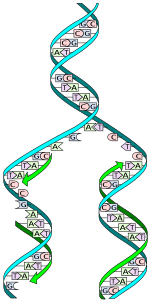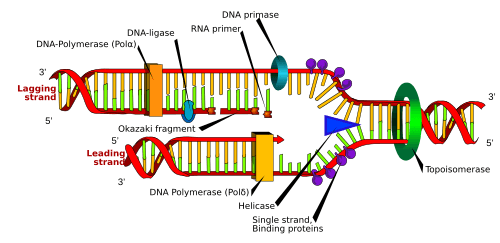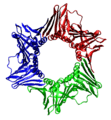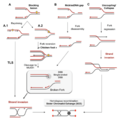DNA replication facts for kids
DNA replication is the process of copying a double-stranded DNA molecule. Both strands serve as templates for the reproduction of the opposite strand. The process is sometimes called "semi-conservative replication" because the new DNA from the original strand contains half of the original and half of the newly synthesized DNA.
This process occurs in all life forms with DNA. There are some differences in the control of DNA replication in prokaryotic and eukaryotic organisms.
In a cell, DNA replication begins at specific places in the genome, called origins. As the DNA unwinds at the origin, the synthesis of new strands forms at a replication fork. In addition to DNA polymerase, other enzymes at the fork help to start and continue the DNA synthesis.
Contents
DNA polymerase
DNA polymerases are a family of enzymes that carry out all forms of DNA replication. However, a DNA polymerase can only extend an existing DNA strand paired with a template strand; it cannot begin the synthesis of a new strand. To begin synthesis, a short fragment of DNA or RNA, called a 'primer', is created and paired with the template DNA strand.
In general, DNA polymerases are extremely accurate, making less than one mistake for every 107 (10 million) nucleotides added. Even so, some DNA polymerases also have 'proofreading' ability: they can remove nucleotides from the end of a strand in order to correct mismatched bases.
DNA repair
DNA in cells is constantly being damaged. The nucleus of cells contains a number of repair mechanisms which fix almost all of this damage. "A large set of DNA repair enzymes continuously scan the DNA and repair any damaged nucleotides".
Images for kids
See also
 In Spanish: Replicación de ADN para niños
In Spanish: Replicación de ADN para niños









